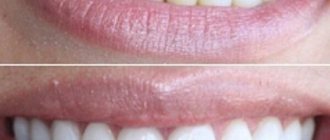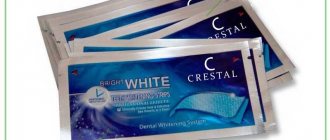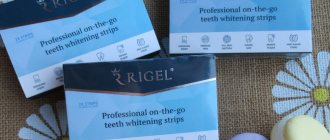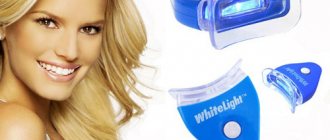From this article you will learn:
- whitening strips – reviews, before and after photos,
- differences between Crest and Blendamed strips,
- price of strips in the pharmacy for 2021.
The article was written by a dentist with more than 19 years of experience.
Whitening strips are designed for chemical teeth whitening at home. The whitening effect is achieved due to hydrogen peroxide, which is applied in the form of a gel to the inner surface of the strips. Their advantages include ease of use, good effectiveness, and a much more affordable price compared to whitening at the dentist.
In Russia, the most well-represented strips for teeth whitening are produced under the brands “Crest 3D White” and “Blendamed 3D White Luxe”. This creates the illusion of choice, but in fact both brands are owned by the same (USA). Compared to Blendamed strips, Crest strips have a higher concentration of hydrogen peroxide.
Teeth whitening strips Crest 3D White and Blendamed 3D White Luxe are good marketing products. You don't have to go to the dentist. It is much cheaper than in the clinic. But why then are the reviews of a fairly large part of patients on teeth whitening strips still far from enthusiastic? In this article we will talk not only about the undoubted advantages of their use, but also the problems that you may encounter.
How do teeth whitening strips work?
Most home teeth whitening systems contain hydrogen peroxide or carbamide peroxide as an active ingredient. Different types of Crest 3D White strips contain different concentrations of hydrogen peroxide - from 9.5 to 14% (we will discuss each type of Crest strips in detail below), and Blendamed 3D White Luxe whitening strips contain 5.25% hydrogen peroxide.
Solutions of hydrogen peroxide and carbamide peroxide are capable of penetrating deeply into tooth tissue with prolonged exposure - to the entire thickness of enamel and dentin. Having penetrated inside, these peroxide compounds decompose there to form free radicals (active oxygen). It is free radicals that lead to the destruction of molecules of chromogenic substances, which give teeth pigmentation.
However, free radicals are not stable compounds and quickly decompose. Therefore, to obtain a whitening effect, hydrogen peroxide must be in contact with the teeth for a sufficiently long time, and it is also necessary to maintain a sufficient concentration. The lower the concentration of hydrogen peroxide in the strips, the longer they will have to be used to get the desired effect.
Free consultation on the cost of treatment in our dentistry
Leave a request and the clinic administrator will contact you within 15 minutes!
The essence of the procedure is that the specialist introduces a special bleaching substance into the dental canal, which causes an oxidation reaction and subsequent discoloration of the colored tooth tissue. After intracanal bleaching, the tooth becomes whiter, but in general, the results of the procedure will depend on the content of active substances in the gel and the time it remains in the canals. To get an aesthetic color and a beautiful smile, during intra-canal whitening it is recommended to visit the doctor strictly according to the established schedule, since if you leave the gel in the tooth too long, the tooth will become too light and will noticeably stand out from the rest.
The intracanal whitening procedure can hardly be called simple. It includes a number of stages. The process begins with the removal of old filling material from the canals, and then the dentist thoroughly cleans them with a specialized instrument - ideally thin taper drills. Next, the canals are treated with disinfectants and only after that a bleaching agent will be introduced into them.
Intra-canal whitening has not only indications for use, but also contraindications, including: childhood, periods of pregnancy and lactation, caries, periodontal inflammation, increased abrasion of the natural enamel coating, noticeable cracks in it. If we talk about the effectiveness and durability of the effect, then on average the results of intra-canal whitening last for a period of 2 to 3 years. If desired, the procedure can be repeated, but you should not abuse its quantity: the more times the chemical reagent is introduced into the tooth tissue, the more fragile they will become.
Before resorting to intra-canal teeth whitening, you should definitely consider the risks of possible undesirable consequences. In particular, after the procedure, dentin becomes more vulnerable to mechanical damage and destruction, and although the enamel will become lighter, it will not acquire a pleasant natural shine. It is difficult to choose the right chemical whitening method on your own, because it is important to take into account a number of nuances. Therefore, do not make a choice yourself - get advice from experienced and competent dentists at the Vanstom clinic! Our clinic is located next to the Baumanskaya metro station, you can make an appointment at any time convenient for you! The price of intra-canal whitening of 1 tooth at VENSTOM dentistry is 2,200 rubles.
Whitening strips Crest 3D White –
Crest strips for teeth whitening (Crest 3D White) - available in 6 different versions. They differ in different concentrations of hydrogen peroxide, the number of strips in the package, and the exposure time of the strips on the teeth. One of the strip options even has a special light source, which apparently should give the consumer the illusion that this product is similar to professional “laser” whitening systems.
But what's really important is that different types of strips hold onto the teeth differently. Some of them can slip on the teeth and do not stick well. When choosing Crest strips, pay attention to the fact that they contain Advanced Seal® technology (allows the strips to adhere firmly to the teeth and not slip on them). Otherwise, the strips will peel off and there will be no close contact of the whitening gel with the enamel surface.
If you have an uneven dentition/crowded teeth, or a pronounced inclination of some teeth, the FlexFit® technology will allow you to achieve good adaptation of the strips to the surfaces of all teeth. In this case, the strips will be slightly elastic (stretch), which will allow them to better adapt to uneven tooth surfaces or uneven dentition shapes. Only Crest 3D White “Supreme FlexFit” strips have this technology. If the strips do not adhere tightly to some surfaces, then the teeth in these areas will remain dark.
How they work
When placing shelves on tooth enamel, hydrogen peroxide begins to actively release oxygen ions, which, penetrating deep into the enamel tissue, destroy organic pigment and lighten the tooth surface. Gels for use by professionals contain increased amounts of hydrogen peroxide. Additionally, to enhance the effect, they are exposed to laser or light. The effect of procedures performed by a dentist occurs after just two procedures.
Whitening strip products are intended solely to whiten natural tooth enamel and do not work on dentures or fillings placed in the mouth. Therefore, if they are installed where they are visible from the outside, and have a color different from the color of the whitened tooth surface, they will stand out from the rest of the teeth. This should be taken into account before carrying out whitening procedures.
Whitening strips: reviews
Let’s say right away that the Crest 3D White “Vivid” strips and especially the Blendamed 3D White Luxe will receive the least good reviews. These versions of the strips do not hold onto the teeth well enough, they slide over them, and if salivation is quite active, it will not be possible to fix them well on the teeth at all, as a result of which there will be no necessary tight contact of the whitening gel with the enamel.
The reviews for White Light teeth whitening are satisfactory. In professional whitening techniques, light sources are used to accelerate the breakdown of hydrogen peroxide in the whitening gel into free radicals, and exposure to light is carried out not after, but during the procedure. In Crest 3D White “With Light” strips, the light is used for 10 minutes after the end of the procedure and, thus, it is not intended to activate the whitening gel.
The portable White Light lamp does not have its own whitening effect, because it is a source of light waves in the “blue” range, and only light waves in the ultraviolet range have a slight whitening effect. Therefore, we believe that the light source in these strips is purely a marketing ploy to make this procedure look like professional laser whitening. This allows us to sell 10 sets of Crest White Light strips - at the price of 20-40 sets of similar sets.
Which Crest strips are better –
We consider the best option for strips to be Crest “Supreme FlexFit”, which is tightly fixed to the teeth and allows the strips to adapt well even in areas of uneven teeth. In 2nd place we would put the Crest “Professional Effects” strips. But we do not recommend using Crest “Supreme Professional” strips with 14% hydrogen peroxide. The fact is that even if the strip does not come into contact with the gums, hydrogen peroxide always gets into the oral fluid due to the contact of the gel with saliva. Therefore, when using a 14% concentration, gum burns and a burning sensation in the throat will be practically guaranteed.
Please note that different versions of strips with the same concentration of hydrogen peroxide of 10% are recommended for different times. Moreover, where the exposure of the strips is 30 minutes, the whitening goes by 3-4 tones, and where the exposure is 60 minutes, by about 6-8 tones. In our opinion, the manufacturer deliberately recommends using essentially the same strips - for different times, so that it does not turn out that cheaper strips will be as effective as more expensive ones.
Crest Professional Effects Strips – Before and After
Crest Vivid strips – before and after photos
CONCLUSIONS: in general, the effectiveness of whitening strips can be very high, and under certain favorable conditions (straight teeth, absence of pigment plaque and dental deposits on the teeth, etc.) - the effect of such home therapy can be practically no different from the result of professional whitening in dentist However, before you buy teeth whitening strips, also read about their disadvantages, which we will tell you about later.
Photo teeth whitening Zoom.
Photo-whitening of teeth is also a chemical method of lightening the enamel coating, however, it uses ultraviolet rather than laser as a reaction activator. Other names of technology are cold whitening, Zoom. The know-how is popular among patients, both because of its high efficiency and harmlessness to the healthy state of the body.
When photobleaching, the surfaces of the teeth are initially treated with a gel containing hydrogen peroxide. Interestingly, the gel is applied exclusively to units in the smile zone, that is, to ten upper and ten lower teeth. The concentration of the active substance is quite high - from 25 to 35%. After this, the outer part of the teeth is exposed to ultraviolet radiation, for which the dentist uses a special lamp - halogen, LED or ultraviolet. The use of ultraviolet light in the procedure allows:
1. Catalyze chemical reactions, due to which colored pigments in the deep layers of the enamel coating of teeth lighten much faster.
2. Reduce the time of manipulation in general. The gel is applied for a short time, which makes it possible to reduce the risk of its harmful effects on the enamel layer.
Positive results from cold whitening are noticeable after the first procedure, but if the darkening of the enamel was initially significant, several sessions may be required. On average, the photobleaching process lasts from 30 minutes to one hour, and after completing all manipulations to lighten the enamel, it is recommended to undergo an additional fluoridation procedure.
The result that is achievable when using the method in question is a change in the shade of the enamel by two or three tones, but the procedure will not make your teeth absolutely snow-white. To maintain the whiteness of the enamel coating, you should exclude coloring foods from your diet for a while. It is also necessary to carefully observe oral hygiene and all the recommendations that a specialist will give you upon completion of all manipulations.
Another significant nuance that you should know about when deciding to resort to cold teeth whitening is that in some cases the enamel may whiten unevenly or after the procedure, previously installed fillings will become noticeable. In such situations, additional procedures are usually performed, which affects the final price of cold whitening for the patient. Is the cold whitening method right for you? The specialists of our dentistry in Moscow, Vanstom, will help you find the answer to this question! To make an appointment with the clinic’s dentist, just call us!
Side effects and disadvantages of whitening strips –
Reviews for whitening strips on all sites are written as carbon copies; the texts of the reviews are more like advertising brochures that praise the strips from different angles, keeping silent about the shortcomings. And although home whitening techniques can indeed be very effective, teeth whitening strips still have significant disadvantages...
They do not whiten fillings and crowns -
Chemical whitening allows you to lighten only the tooth tissue. Fillings, veneers, and any types of artificial crowns cannot be bleached. This means that if you have fillings or crowns on one or more teeth, then after whitening they will look even darker against the background of the whitened enamel of the remaining teeth (Fig. 14). Whitening in such situations will mean the need to subsequently replace veneers, crowns and fillings with lighter shades.
It should also be taken into account that after a few months, the teeth will gradually begin to darken again (the speed of teeth darkening after whitening is related to your habits, for example, smoking, the frequency of drinking coloring drinks and foods). This may mean the need for either new replacement fillings, veneers or crowns, or ongoing periodic courses of home whitening.
Uneven whitening –
Reviews of teeth whitening strips are often negative due to the fact that although the front surfaces of the teeth become much whiter, they remain dark in the interdental spaces. This creates a sharp contrast between dark and light, and the interdental spaces end up looking like black triangles (Fig. 15). Why is this happening...
Firstly, the thickness of the whitening gel on the inner surfaces of the strips is only about 0.2 mm. At the same time, the surface of the teeth is not absolutely smooth, and therefore, when adapting the strips to the teeth, the whitening gel simply does not penetrate sufficiently into the interdental spaces. The second reason lies in the uneven position of the teeth, for example, when they are crowded. In this case, adapting the whitening strip to teeth located deeper (lingually) will be very false, which will mean poor contact of the whitening gel with these teeth.
Thirdly, the problem is that most people use Blendamed or Crest whitening strips without first removing plaque and plaque from the dentist. The fact is that the surfaces of teeth covered with pigment plaque whiten a priori much worse, because coating on these areas will prevent hydrogen peroxide from penetrating into them. And therefore the surface of the teeth in these areas will remain dark.
Pain and sensitivity of teeth -
Clinical studies by Cooperetall in 1992 showed that the penetration of free radicals into the dental pulp occurs within 15 minutes after applying 3% hydrogen peroxide gel to tooth enamel. It is this process, as well as a certain degree of demineralization of enamel and dentin, that leads to the development of increased sensitivity of teeth after whitening.
Sensitivity is expressed in the appearance of pain to thermal stimuli (heat, cold). And the longer the bleaching course continues and/or the higher the concentration of hydrogen peroxide, the stronger the sensitivity will be every day. In this case, you can start using special pastes to relieve sensitivity, or reduce the exposure time of the strips on the teeth, or start using them every other time. And after completing the whitening course, it is worth taking a course of remineralization or fluoridation of teeth.
Important: if you have erosions, carious lesions, deep wedge-shaped defects with exposed dentin on your teeth, then you can predict a very high rate of hydrogen peroxide entering the dental pulp (neurovascular bundle) - with the development of severe pain, and even a chemical burn of the pulp , which may then even require removal of the nerve from the tooth. Therefore, caries and wedge-shaped defects must be cured before using whitening strips (24stoma.ru).
Burns and inflammation of the gums, throat irritation -
About half of all patients also complain of sore gums after using whitening strips. The fact is that the whitening strips have a straight shape - in contrast to the gum line, and therefore, when applying the strips to the teeth, they always come into contact with the interdental gingival papillae. As we said above, the strips are coated with a gel with hydrogen peroxide with a concentration of 5.25 to 14% (10% on average), which contributes to the development of a chemical burn of the gums.
Inflammation and burn of gums after whitening –
But gel with hydrogen peroxide can cause harm not only to the gums. The whitening gel is located in the moist environment of the oral cavity, so some of the hydrogen peroxide necessarily gets into the saliva. This means that hydrogen peroxide will affect not only the interdental papillae, but also other areas of the gums and the tongue. In addition, when you swallow saliva, hydrogen peroxide will contact the mucous membrane of the throat, causing irritation. To reduce such side effects, always rinse your mouth after removing strips, reduce exposure time, or use strips with a lower concentration.
White spots on teeth -
When you remove the whitening strips, you can often notice white spots appearing on the enamel. In most cases this is not a problem, because... occurs due to drying out of the enamel area due to the fact that the strips isolate the front surface of the teeth from contact with saliva. Such stains disappear after a few hours (after the enamel is saturated with moisture).
However, if you use low-quality whitening strips (the whitening gel will have an acidic pH), you can end up with chalky white spots on your enamel that will last a lifetime. This can also happen if the enamel of your teeth has poor resistance to chemical and mechanical factors, which occurs against the background of demineralization of the enamel. Generalization means that your enamel contains very little calcium, i.e. as if porous.
If there are white chalky spots on your teeth even before whitening, then this is one of the signs of enamel demineralization, which means that any type of chemical whitening will be contraindicated for you. The use of chemical bleaching against the background of enamel demineralization will lead to an even greater loss of calcium from dental tissues, which will increase the risk of tooth decay (as a result of increased abrasion or the development of caries).
Free consultation on the cost of treatment in our dentistry
Leave a request and the clinic administrator will contact you within 15 minutes!
It is worth considering that any methods using chemicals have a number of limitations. You should not use whitening chemicals if there are units in your mouth with untreated caries, worn out and old fillings, old and hardened deposits, or inflammation of the soft tissues of the mouth. If there are such contraindications, it would be advisable to visit a specialist and, during a dentist appointment, carry out both high-quality sanitation of the oral cavity and the elimination of all problems that will interfere with the teeth whitening procedure.
Good to know: some modern teeth whitening pastes contain urea peroxide, and advertising assures that teeth will whiten simply by brushing them, since this component can not only erase dense plaque, but also lighten the pigments in the enamel coating itself. However, advertising and the manufacturer greatly exaggerate the effectiveness of such pastes.
They contain peroxide in low concentration, and therefore you should not count on a positive result in lightening the shade of enamel when using the paste. In addition, none of the lightening pastes contain acidic components, which make the enamel porous and thereby contribute to its rapid lightening. Therefore, we advise you not to waste your money and time and buy only those products for home procedures that your dentist recommends.
How harmful are whitening strips to tooth enamel?
Hydrogen peroxide, with prolonged exposure, penetrates not only into the entire depth of enamel and dentin, but even into the dental pulp (neurovascular bundle). There are numerous studies that confirm the slight negative effect of peroxide compounds on tooth tissue...
- Chemical bleaching with hydrogen peroxide can negatively affect the surface texture and shine of the enamel if the gel on the surface of the whitening strips has an acidic pH. In this case, erosions, chalky spots with a matte surface may appear on the enamel surface, and loss of enamel shine may occur. High-quality whitening strips contain sodium hydroxide or its analogues (make the pH neutral).
- Clinical studies by Sighiand Denry 1992 and McCracken et al. 1996 - showed that chemical bleaching leads to a slight decrease in the strength of enamel and its wear resistance to abrasives and chemicals. This occurs due to demineralization of enamel and dentin, i.e. their loss of calcium. Studies have confirmed that the preventive use of a course of fluoride after the end of a whitening course can significantly improve the situation.
- But the most important thing is that chemical whitening disrupts the bond between tooth dentin and filling materials (light composites, glass ionomer cements). This is confirmed by studies by Della Bona et al. 1992, “Tiunsakeretall” 1990, “Titleyetall” 1991. As a result, the marginal fit of the filling to the tooth tissue deteriorates, which can lead to the development of caries at the filling/tooth interface, as well as the need to replace fillings.
Conclusions: whitening strips with a concentration of hydrogen peroxide up to 10% inclusive are a fairly safe product for home use that does not cause critical changes in the teeth (provided that the product has a slightly alkaline pH, there are no carious lesions on the teeth, and also when good oral hygiene). A slight decrease in the degree of mineralization of enamel and dentin can be compensated for by subsequent courses of remineralization and fluoridation of tooth enamel.
Amazing white
Amazing White is a professional teeth whitening system with an Apoza Pluslit LED lamp (USA). It emits cold light and does not heat the tissue, so side effects such as pulpitis are excluded. Used with a gel based on hydrogen peroxide, in which, under the influence of a lamp, atomic (active) oxygen is released, which has a pronounced reactivity. This is a safe oxidizing agent that effectively removes biologically active contaminants and cleanses the enamel of toxic bacteria.
Advantages
- Whitening in one session (color change up to 10 shades).
- Removing persistent pigmentation from enamel and deep layers.
- Teeth acquire a natural tone, without an artificial bright white “tiled” color.
Flaws
- Teeth with fillings cannot be whitened.
- There may be a short-term increase in tooth sensitivity.
Whitening stages
- Determination of enamel color.
- Application of gel.
- Clinical whitening using a lamp, stage duration – 15 minutes.
- Removing the gel, reapplying, whitening for 15 minutes (second stage).
- The third stage is similar to the second. The session consists of 3 stages and takes approx. 60 min.
Whitening strips: application diagram
Manufacturers of whitening strips recommend not brushing your teeth before using them, arguing that in this case the bacterial film on the surface of the gums will protect them from excessive irritation. This makes a certain sense, but this does not mean at all that you should have food residues in the spaces between your teeth, and traces of soft plaque at the necks of your teeth. Please note that the interdental spaces must be cleaned with dental floss.
1) Preparing to apply the strips - To improve the adherence of the strips to the teeth, you can remove excess saliva from the front surfaces of the teeth using a dry gauze pad.
2) Applying strips - next, take a wider and shorter strip and, having separated it from the protective layer, carefully, without much pressure, apply it with the gel side to the front surface of the lower teeth. The bottom edge of the strip should run along the gum line. After you are sure that the strip is positioned correctly, press it against your teeth for 2-3 seconds.
Then fold the upper edge of the strip over the cutting edge of the lower front teeth and also press for 2-3 seconds. Fix the second (narrower and longer strip) in the same way - on the teeth of the upper jaw. The exposure time of the strips on the teeth is usually from 30 to 60 minutes, according to the type of strips and instructions.
What the overlay of stripes looks like: video
3) Clean your hands – when applying the strips, you will definitely get the hydrogen peroxide gel on your fingertips. The smallest thing that can happen is that your fingertips turn white. It will be much worse if you rub your face with unwashed hands or get the gel into your eyes, or if the gel gets from your hands onto the fur or skin of pets. Also, very often patients spoil their clothes, because... Hydrogen peroxide will permanently lighten areas of tissue where it gets in contact.
4) Additional recommendations - as we said above: hydrogen peroxide will in any case get from the whitening gel on the strips into the oral fluid. To avoid unnecessary irritation of the gums and throat, it is advisable to periodically spit out saliva without swallowing it. This process is not very pleasant, so try to use the strips at times when you are not actively salivating (i.e. not on an empty stomach). A small amount of saliva can be swallowed without fear of the above side effects.
If you begin to feel a burning sensation in your gums or throat, immediately remove the strips and rinse the oral mucosa with plain water. Perhaps next time you will need to reduce the time for fixing the strips on your teeth, or start doing them every other time (this will simply lengthen the whitening course), or purchase strips with a lower concentration of hydrogen peroxide. And lastly, after completing such a home whitening course, always have your enamel fluoridated at the dentist.
Also, during the whitening course, you should give up highly abrasive toothpastes to compensate for the temporary decrease in enamel wear resistance, as well as drinks and foods with a high acid content (wine, fruit juices...), as well as smoking. If you use an electric toothbrush for hygiene, then for some time it is better to use either the attachment for sensitive teeth or the “gentle brushing” mode without pulsating movements.
Rules for use at home
How to use teeth whitening strips? The use of whitening strips is carried out only at home, and there must be a supply of clean water (at least 1 glass), it will be needed after using the bleaching agent. Each manufacturer provides their products with detailed instructions, which you must read before use. The features of using different strips differ little from each other and include the following steps:
- brushing your teeth 60-30 minutes before the procedure: it is better not to use a brush immediately before use, because you can scratch your gums a little, and then peroxide will get into the wound and cause irritation,
- you need to take the top strip and peel off the film on one side: this will reveal the inner layer of the whitening gel,
- the strip is applied to the dentition flush with the gum and pressed tightly, with the side with the gel facing the enamel (be careful),
- the free lower part of the strip is folded onto the back side of the dentition and is also pressed tightly,
- the next strip (short) is glued to the bottom row by analogy: the order of gluing may be different - first the bottom, then the top, as indicated by the manufacturer,
- you need to wait a while for the active substances to act,
- remove the strips and rinse your mouth several times with clean water, brush your teeth with a soft-bristled brush.
Gluing is best done with clean, dry hands in a well-lit room. The presence of a mirror is mandatory for the first 3-4 uses.
Contraindications for bleaching –
The development of allergic reactions to the whitening strips Cross and Blendamed is possible. If you are allergic to any of the components, you must avoid using them. There are also a number of diseases and conditions in which the use of whitening strips will be contraindicated.
Contraindications to whitening strips –
- presence of enamel erosions,
- the presence of areas of enamel demineralization (in the form of white chalky spots),
- the presence of untreated caries,
- with the frequent appearance of new carious lesions,
- the presence of deep wedge-shaped defects with exposure of dentin,
- during pregnancy and breastfeeding,
- for diabetes mellitus,
- You must stop smoking for the entire whitening period.
- with severe degrees of fluorosis, enamel hypoplasia or tetracycline staining,
- in adolescents under 18 years of age (at this age there is still a large volume of pulp chambers, which can lead to a chemical burn of the pulp and the need for tooth depulpation).
Which method do you recommend?
The choice will primarily depend on the problem with which the visitor came to the pharmacy. If yellowness is associated with food, bad habits or insufficient hygiene, a pharmaceutical specialist may advise changing the usual paste to a whitening one and additionally offering mouth guards, gels, pencils or strips for use once a week or a short course (the course depends on the type of product).
It is also worth warning that the effect of home whitening will always be less pronounced than that of professional whitening. This will help eliminate objections in the future and prevent the formation of inflated expectations from the procedure. It is better to recommend products from the same series and line, since they usually complement each other and are compatible in composition.
When consulting, it is imperative to clarify whether the patient has caries, whether teeth have been restored or dentures have been installed. If you have cavities or black staining, it is important to recommend seeking help from a dentist. It is also necessary to refer the patient to a doctor if there is a suspicion of diseases of the internal organs, for example, liver diseases, diabetes, oncology, etc. You can assume this problem in a person by asking questions. If previously the color of the teeth was one, but then changed and other symptoms are observed: pain in a certain area, itching of the skin, excessive urination or sweating, etc., in this case it is definitely recommended to refer the patient to a doctor.
Candidates for veneers
Good candidates for veneers may suffer from a variety of cosmetic concerns, including:
- stained teeth
- Chipped teeth
- Cracks in teeth
- Interdental spaces
- Asymmetry of teeth
- Slight curvature
The versatility of porcelain veneers is part of their popularity among patients and dentists.
Advantages
Lamellar products for enamel whitening are attractive for many reasons:
- they are easy to use, so they can be used independently;
- allow you to quickly get the desired result;
- do not destroy enamel;
- safe to use;
- the result lasts for a long time (up to 1.5 years).
Special toothpastes
This is the most affordable way to whiten teeth at home. As a rule, these pastes contain abrasive particles that remove plaque and polish the enamel, making it lighter.
The main advantage of all home whitening methods is that they are affordable. But with their help, it will be possible to lighten the enamel by no more than 2–3 tones, and to maintain this effect, the procedures will have to be repeated with enviable regularity.
Important to remember!
Uncontrolled use of home teeth whitening methods can damage the enamel and cause its thinning. In addition, all of them, like professional methods, have their contraindications and require prior consultation with a dentist.
How to use
When carrying out the procedures yourself, you need to carefully read the instructions and check the composition to make sure that it does not contain components to which you may be allergic. Then you need to remove the film protecting the gel and apply the strip with the active side to the surface of the enamel of the teeth for which it is intended. It is better to apply the application in front of a mirror.
Using light finger pressure, gently straighten the strip, eliminating all folds and voids. The exposure time of the strips on the tooth surface should be from 5 to 30 minutes, it all depends on the manufacturer of the products. The procedure must be carried out at least once a day. Using the strips twice a day, 12 hours apart, may speed up the effect. It is unacceptable to reuse strips that have been used. The procedure with one strip should also not take longer than the recommended time, otherwise the enamel may be damaged.
You should not drink, eat or sleep with the strips attached, as they may come off the surface of the enamel and the gel will enter the stomach. After the procedure, carefully remove the plate from your mouth, rinse it with water and brush your teeth with toothpaste. The course of procedures is about 7 days. During this time, you should not eat food with a dye, such as tea and coffee, and you should not smoke. If these rules are not followed, the opposite effect may occur. It is not recommended to brush your teeth with toothpaste before the procedure.
Clinical methods
If after lightening your teeth become overly sensitive and susceptible to pain, this is not a reason to give up the desired dazzling smile. Teeth hurt after whitening - this can be corrected in one or several visits to the dentist with the help of fluoridation, remotherapy or remineralization with electrophoresis.
During the procedure, tissues are saturated with useful substances, strengthened, restored and increased resistance to external irritants. Therefore, even if the tooth surface is damaged during lightening, it will quickly return to normal.
We looked at the main options for when teeth hurt after whitening, how to soothe the pain and how to relieve surface hypersensitivity. But if you experience severe, persistent pain, you should immediately consult a specialist.









